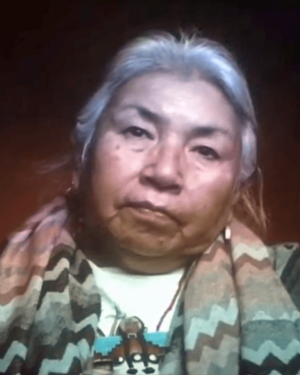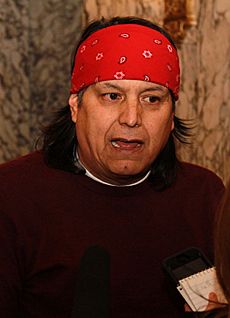Faith Spotted Eagle facts for kids
Quick facts for kids
Faith Spotted Eagle
Tȟuŋkáŋ Inážiŋ Win |
|
|---|---|
 |
|
| Born | 1948 (age 76–77) Lake Andes, South Dakota, U.S.
|
| Alma mater | University of South Dakota |
| Occupation | PTSD counselor, educator |
| Known for |
|
| Political party | Democratic |
Faith Spotted Eagle (whose name in the Dakota language is Tȟuŋkáŋ Inážiŋ Win, meaning "Standing Stone"; born in 1948) is an important American activist and politician. She is a member of the Yankton Sioux Tribe. She has worked hard to stop big oil pipelines like the Keystone XL pipeline and the Dakota Access Pipeline.
In the 2016 United States presidential election, she made history. She became the first Native American person to receive an electoral vote for President of the United States. She was also one of the first two women to ever receive such a vote. Faith Spotted Eagle's single vote came from Robert Satiacum Jr.. He was an elector from Washington who chose to vote for her instead of Hillary Clinton.
Contents
Early Life and Education
Faith Spotted Eagle grew up in the village of White Swan. This village is now underwater, beneath Lake Francis Case. This lake was created by the Fort Randall Dam. She still lives close by, near Lake Andes, South Dakota.
She studied at American University in Washington, D.C.. She also attended Black Hills State College in Spearfish, South Dakota. Later, she earned a master's degree in Educational Psychology and Counseling from the University of South Dakota. During her studies, she even worked for Senator George McGovern. Faith Spotted Eagle is a native speaker of the Lakota language. She learned English when she went to school.
Her Work as an Activist
Faith Spotted Eagle has done many different jobs. She has helped veterans as a counselor for PTSD. PTSD means Post-Traumatic Stress Disorder, which is when people have strong, upsetting feelings after a difficult experience. She has also worked as a school counselor and principal. She taught the Dakota language at Sinte Gleska College.
She helped start the Brave Heart Society. This group teaches young girls about traditional Native American culture. She also leads the Ihanktonwan Treaty Committee. This committee works to protect the rights and agreements of her people. She manages the Brave Heart Lodge in Lake Andes. This lodge helps keep Dakota cultural beliefs alive for future generations. Faith Spotted Eagle has even represented her Treaty Committee at the United Nations.
She has spoken out against disrespectful comments. For example, she criticized President Donald Trump for using the name "Pocahontas" to refer to Senator Elizabeth Warren. She said it was like an "emotional attack." She felt that name should not be used in that way.
Her Political Journey
Running for State Office
Faith Spotted Eagle has run for political office in her home state of South Dakota. In 2006, she ran for a seat in the South Dakota House of Representatives. She did not win that election. However, she received the most votes in Buffalo County, where many Native Americans live.
The 2016 Presidential Election Vote

In the 2016 presidential election, Faith Spotted Eagle received a special vote. An electoral vote is cast by a person chosen to represent their state's voters. Robert Satiacum Jr. from Washington state was one of these electors. He chose to vote for Faith Spotted Eagle instead of the candidate his state voted for. This made him a "faithless elector."
Satiacum explained that he voted for Faith Spotted Eagle because he felt the other candidates had not supported Native Americans enough. He was especially concerned about the oil pipelines. Faith Spotted Eagle was surprised to learn she received this vote. She hoped it would help people understand the dangers of projects like the Keystone XL pipeline.
This event was historic. Faith Spotted Eagle became the first Native American person to receive an electoral vote for President. She and Hillary Clinton were also the first two women to receive an electoral vote for president.
Running Again in 2018
In 2018, Faith Spotted Eagle ran again for the South Dakota House of Representatives. She wanted to represent District 21. She did not win enough votes in the primary election. However, one candidate later dropped out, putting her back in the race for the general election. In the end, she did not win a seat.
See also
- Faithless electors in the United States presidential election, 2016
- List of people who received an electoral vote in the United States Electoral College
- Charles Curtis, the first person with significant Native American ancestry to receive an electoral college majority vote, for vice-president in 1928
- Tonie Nathan, the first woman to receive an electoral college vote, for vice president in 1972

